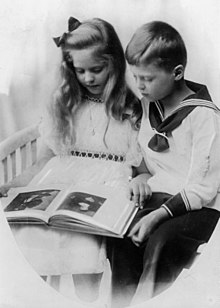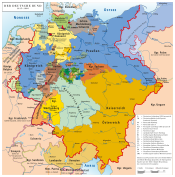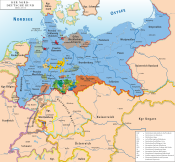Saxe-Coburg and Gotha
Saxe-Coburg and Gotha Sachsen-Coburg und Gotha | |||||||||||||
|---|---|---|---|---|---|---|---|---|---|---|---|---|---|
| 1826–1920 | |||||||||||||
| Anthem: Heil unserem Herzog, heil | |||||||||||||
 The Duchy of Saxe-Coburg and Gotha | |||||||||||||
| Capital | Coburg and Gotha | ||||||||||||
| Common languages | German | ||||||||||||
| Government | Monarchy | ||||||||||||
| History | |||||||||||||
• Established | 1826 | ||||||||||||
• German Revolution | 18 November 1920 | ||||||||||||
| Area | |||||||||||||
| 1905 | 1,977 km2 (763 sq mi) | ||||||||||||
| Population | |||||||||||||
• 1905 | 242,000 | ||||||||||||
| |||||||||||||
Saxe-Coburg and Gotha or Saxe-Coburg-Gotha (German: Herzogtum Sachsen-Coburg und Gotha) served as the collective name of two duchies, Saxe-Coburg and Saxe-Gotha, in Germany. They were located in what today are the states of Bavaria and Thuringia, respectively, and the two were in personal union between 1826 and 1918. The Duchy came to an end in 1918 with the other German monarchies, and the Free State of Saxe-Coburg-Gotha was established. This was merged into the new state of Thuringia two years later.
The name Saxe-Coburg-Gotha also may refer to the family of the ruling House of Saxe-Coburg and Gotha, which played many varied roles in nineteenth and twentieth-century European dynastic and political history, branches of which currently reign in Belgium and the Commonwealth realms.
History
The two duchies, Saxe-Coburg and Saxe-Gotha, were among the Saxon duchies held by the Ernestine branch of the Wettin dynasty. The duchy of Saxe-Coburg and Gotha originated as the personal union of these two duchies in 1826, after the death of the last Duke of Saxe-Gotha-Altenburg, who died without male heirs. His Wettin relations repartitioned his lands. The former husband of Louise of Saxe-Gotha-Altenburg, the only niece of the last duke, was Duke Ernst III of Saxe-Coburg-Saalfeld. He received Gotha and changed his name and title to Ernest I, Duke of Saxe-Coburg and Gotha although, technically, the two duchies remained as separate duchies.
Ernst I died in 1844. His elder son and successor, Ernst II, ruled until his own death in 1893. As he died childless, the throne of the duchies would have passed to the male descendants of Ernst's late brother Albert, the Prince Consort, husband of Queen Victoria of the United Kingdom. However, the constitutions of both duchies excluded the British heir apparent from the ducal thrones if there were other eligible male heirs,[1] although Albert Edward, Prince of Wales had already renounced his claim to the ducal throne in favour of his next brother, Prince Alfred, Duke of Edinburgh.
Alfred's only son, also named Alfred, committed suicide in 1899, so when Duke Alfred died in 1900, he was succeeded by his nephew the Duke of Albany, the sixteen-year-old son of Queen Victoria's youngest son, Leopold. Alfred's next brother Prince Arthur, Duke of Connaught and his son Prince Arthur of Connaught having renounced the succession. Reigning as Duke Carl Eduard, or Charles Edward, under the regency of the Hereditary Prince of Hohenlohe-Langenburg until he came of age in 1905, the new duke also continued to use his British title, Duke of Albany. As a result of Charles Edward fighting for Germany against the British in the First World War, he was stripped of his British titles in 1919.[2]
Charles Edward reigned until November 18, 1918 during the German Revolution, when the Workers' and Soldiers' Council of Gotha deposed him. The two Duchies, now without a common ruler, became separate states until shortly thereafter, when they ceased to exist. Saxe-Coburg became a part of Bavaria and Saxe-Gotha merged with other small states in 1920 to form the new state of Thuringia in the Weimar Republic.
The capitals of Saxe-Coburg and Gotha were Coburg and Gotha. By 1914 the area and populations of the two duchies were:[3]
| Duchy | Area | Population | |
|---|---|---|---|
| km² | sq mi | ||
| Saxe-Coburg | 562 | 217 | 74,818 |
| Saxe-Gotha | 1,415 | 546 | 182,359 |
| Total | 1,977 | 763 | 257,177 |
Saxe-Coburg-Gotha was the only European country to appoint a diplomatic consul to the Confederate States of America during the American Civil War. This consul, Ernst Raven, was assigned to a position in the state of Texas. Raven applied to the Confederate Government for a diplomatic exequatur on July 30, 1861 and was accepted.[4][full citation needed]
Ruler

According to the House law of the Duchy of Saxe-Coburg and Gotha the full title of the Duke was:
Wir, Ernst, Herzog zu Sachsen-Coburg und Gotha, Jülich, Cleve und Berg, auch Engern und Westphalen, Landgraf in Thüringen, Markgraf zu Meißen, gefürsteter Graf zu Henneberg, Graf zu der Mark und Ravensberg, Herr zu Ravenstein und Tonna usw.
Translation: We, Ernst, Duke of Saxe-Coburg and Gotha, Jülich, Cleves and Berg, also Angria and Westphalia, Landgrave in Thuringia, Margrave of Meissen, Princely Count of Henneberg, Count of the Mark and Ravensberg, Lord of Ravenstein and Tonna, et cetera.
Dukes, 1826–1918
- Ernst I 1826–1844
- Ernst II 1844–1893
- Alfred 1893–1900
- Carl Eduard 1900–1918
Heads of the House since 1918
- Carl Eduard 1918–1954
- Prince Friedrich Josias 1954–1998
- Prince Andreas 1998–present
Title and Style of other members of the House
Use of titles may be restricted in case of marriage in opposition to House laws or a member renouncing for themselves and their descendants.[citation needed]
See also
- Ernestine duchies
- Palais Coburg in Vienna
References
- ^ Sandner, Harold. "II.1.4 Prinz Albert". Das Haus von Sachsen-Coburg und Gotha 1826 bis 2001 (in German). Andreas, Prinz von Sachsen-Coburg und Gotha (preface). 96450 Coburg: Neue Presse GmbH. p. 86. ISBN 3000085254.
Der zukünftige König von England und der vorraussichtliche englische Thronfolger sind von der von Regierung im Herzogtum ausgeschlossen
{{cite book}}: CS1 maint: location (link) - ^ "No. 31255". The London Gazette. 28 March 1919.
- ^ Sandner, Harold. "I.11 Herzogtum Sachsen-Coburg und Gotha". Das Haus von Sachsen-Coburg und Gotha 1826 bis 2001 (in German). Andreas, Prinz von Sachsen-Coburg und Gotha (preface). 96450 Coburg: Neue Presse GmbH. p. 27. ISBN 3000085254.
{{cite book}}: CS1 maint: location (link) - ^ http://memory.loc.gov/ll/llcc/005/0400/04240422.gif
External links
- The Ducal House of Saxe-Coburg and Gotha – the official website of the house, in German and English
- The Catholic Encyclopedia: Saxe-Coburg and Gotha – article about the duchy, with details of religious issues, written in 1910)
- Chisholm, Hugh, ed. (1911). . Encyclopædia Britannica (11th ed.). Cambridge University Press.






